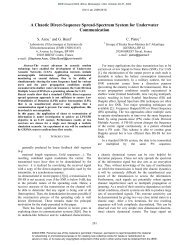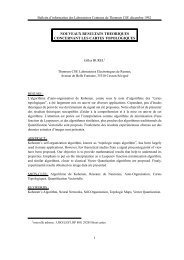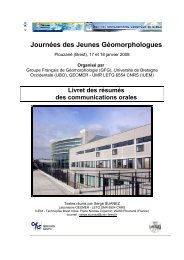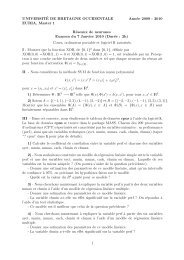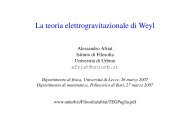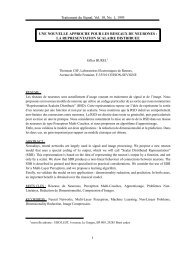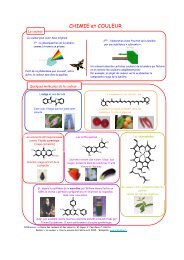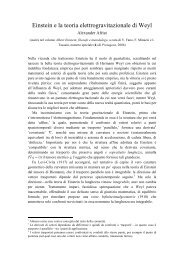Abstract 1 Introduction
Abstract 1 Introduction
Abstract 1 Introduction
Create successful ePaper yourself
Turn your PDF publications into a flip-book with our unique Google optimized e-Paper software.
Battleeld Atmospherics Conference (BAC’93), Nov 30 - Dec 2, 1993, Las Cruces, New Mexico, USA<br />
vector. The input vectors are extracted from a set A, called “the learning set”. This<br />
set contains cardA vectors. Each neuron is characterized by a vector of weights<br />
W j [W 1 j W Kj ] T ,where j is the index of the neuron. In response to an input vector x,<br />
the neuron such that the quadratic distance W j x 2 is minimal is called the winner. We<br />
will note O j the output of neuron j:<br />
O j W j x 2 <br />
K<br />
W ij x i 2<br />
i1<br />
The learning algorithm is the following (t is the iteration index, and T is the total<br />
number of iterations):<br />
1. t 0<br />
Initialization of the weight vectors W 1 W 2 W M <br />
2. n 1<br />
Let be a random permutation of the set 1 2 cardA<br />
3. Presentation of the vector xn on input.<br />
4. Computation of neurons outputs O j<br />
5. Determination of the winner (neuron k which provides the lowest output)<br />
6. Modication of the weights according to:<br />
7. n n 1<br />
If n cardA,goto(3)<br />
8. t=t+1<br />
If t T go to (2)<br />
W j jk t[x W j ]<br />
The coefcients jk t are of the form t d j k. The distance d denes the dimension<br />
of the network. For 1D networks arranged in ring, such as the one we used for our<br />
application, we have d j k min j k M j k.Weproposetouse:<br />
jk t 0 e d2 jk<br />
2t<br />
2<br />
The constant 0 is called “the learning rate”. Kohonen suggests values around 10 1 .The<br />
standard deviation t decreases with t according to an exponential rule:<br />
t<br />
T 1<br />
T 1<br />
t 0<br />
0<br />
5



